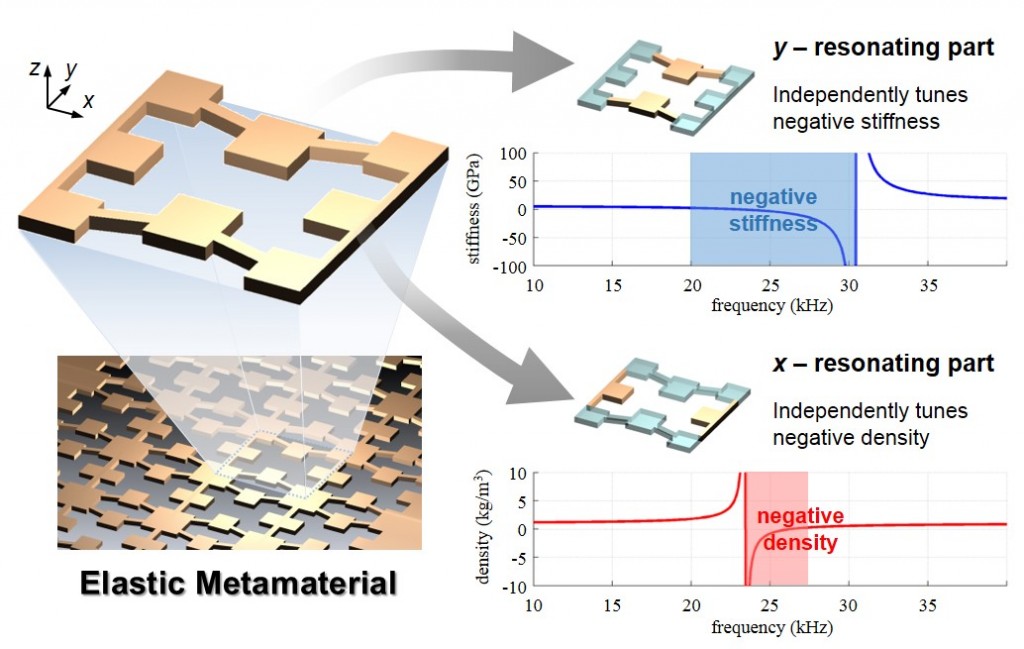메타물질이란 매우 작은 미소구조의 배열로 이루어진 물질로, 일반적인 물질에서는 볼 수 없는 독특한 특성을 가지는 물질을 의미합니다. 무엇보다도 메타물질은 미소구조의 형상에 따라 기존에는 불가능하다 여겨진 음의 밀도와 음의 강성을 구현하는 것이 가능한 특징이 있습니다. 아래 그림은 실제로 제작된 탄성 메타물질을 통하여 음의 강성과 음의 밀도가 구현된 사례입니다. (Oh et al., 2016, Sci. Rep.) 이러한 독특한 특성으로 인하여 메타물질은 기존 물질과는 전혀 다른 동적인 특성을 보이며, 이를 잘 응용한다면 흥미로운 진동, 음향 및 파동 시스템을 만들어 낼 수 있습니다.
Metamaterials are artificial materials consisting of arrays of microstructures. Owing to the microstructure’s unique configuration, metamaterials can exhibit extraordinary properties that cannot be observed with general materials. For example, metamaterials can provide negative density or stiffness, which has been considered impossible to be achieved. Below is a photo of an elastic metamaterial which realized negative density and stiffness (Oh et al., 2016, Sci. Rep.). Accordingly, metamaterials exhibit interesting dynamic phenomena that are largely different from general materials. By utilizing their extraordinary characteristics, we can use metamaterials to design interesting vibration, acoustics and wave systems.

Fig. 1. Elastic metamaterial realizing negative density and stiffness (Oh et al., 2016, Sci. Rep.)
예를 들어, 매질이 존재한다면 해당 매질을 통해 파동이 전파할 수 있음은 이미 잘 알려진 사실입니다. 그러나 메타물질을 통해 음의 밀도 혹은 음의 강성을 구현한다면, 매질이 존재함에도 불구하고 파동 (혹은 진동이나 음향)이 존재할 수 없게 되며 외부의 진동/파동은 모두 반사됩니다. 아래 그림은 음의 밀도와 음의 강성을 통하여, 20 kHz 에서 36 kHz의 주파수 대역에서 거의 0%의 파동 투과율, 즉 100%에 가까운 파동 차단을 얻어낸 연구 결과입니다. (Oh et al., 2016, Sci. Rep.; Oh et al., 2016, Appl. Phys. Lett.) 이러한 메타물질을 응용한다면 진동이나 소음을 거의 완벽하게 차단하는 것이 가능하며 결과적으로 기존의 진동/소음 차단 시스템보다 훨씬 뛰어난 성능의 새로운 시스템을 구현하는 것이 가능합니다.
For example, it is well known that if there is any media, there can be waves propagating inside the media. However, waves (or vibrations or acoustics) cannot exist inside a metamaterial with negative density or stiffness. Thus, at the boundary of the metamaterial, waves are totally reflected. Below is the experimental result of the elastic metamaterial with negative density and stiffness. Nearly none of the wave was transferred through the metamaterial – In other words, ~100% wave shielding was obtained, at the frequency range of 20 kHz to 36 kHz. This result demonstrates that by using the metamaterial with negative density or stiffness, we can obtain near-perfect vibration and noise shielding. This can provide a new mechanical system that goes beyond the current technical limit of vibration/noise shielding systems (Oh et al., 2016, Sci. Rep.; Oh et al., 2016, Appl. Phys. Lett.).

Fig. 2. Elastic metamaterial for broad-band wave shielding (Oh et al., 2016, Appl. Phys. Lett.)